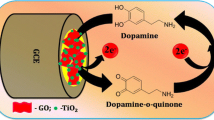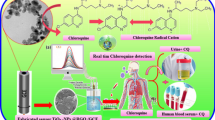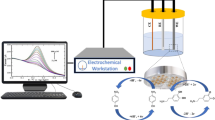Abstract
We describe a high-performance nitric oxide (NO) sensor by using a nanocomposite consisting of platinum-tungsten alloy nanoparticles, sheets of reduced graphene oxide and an ionic liquid (PtW/rGO-IL) that was deposited onto the surface of a glassy carbon (GC) electrode. The modified GC electrode exhibits excellent electrocatalytic activity toward the oxidation of NO with a strong peak at 0.78 V vs. Ag/AgCl due to the synergistic effects of bimetallic PtW nanoparticles, reduced graphene oxide nanosheets and an ionic liquid. The sensor possesses a detection limit as low as 0.13 nM, high sensitivity (3.01 μA μM−1 cm2), and good selectivity over electroactive interferents that may exist in biological systems. The sensor was tested to selectively distinguish NO in actual human serum and urine samples, confirming potential practical applications. In our perception, the approach described here may be extended to the fabrication of various kind of composites made from metal nanostructures, graphene and ionic liquids for medical and environmental analysis.

Enhanced electrochemical sensing of nitric oxide (NO) is demonstrated by utilizing the synergistic effects of bimetallic PtW nanoparticles dispersed on reduced graphene oxide and ionic liquid nanocomposite.





Similar content being viewed by others
References
Hunter RA, Schoenfisch MH (2015) S-nitrosothiol analysis via photolysis and amperometric nitric oxide detection in a microfluidic device. Anal Chem 87:3171–3176
Zheng D, Liu X, Zhu S, Cao H, Chen Y, Hu S (2015) Sensing nitric oxide with a carbon nanofiber paste electrode modified with a CTAB and nafion composite. Microchim Acta 182:2403–2410
Zhang ZX, Guo XF, Wang H, Zhang HS (2015) Capillary electrophoresis strategy to monitor the released and remaining nitric oxide from the same single cell using a specially designed water-soluble fluorescent probe. Anal Chem 87:3989–3995
Hall CN, Garthwaite J (2009) What is the real physiological NO concentration in vivo? Nitric Oxide 21:92–103
Cancino J, Borgmann S, Machado SAS, Zucolotto V, Schuhmann W, Masa J (2015) Electrochemical sensor for nitric oxide using layered films composed of a polycationic dendrimer and nickel (II) phthalocyaninetetrasulfonate deposited on a carbon fiber electrode. Microchim Acta 182:1079–1087
Li F, Nie M, Fei J, Ding Y, Feng B (2014) Direct electrochemistry and electrocatalysis of hemoglobin on a glassy carbon electrode modified with poly (ethylene glycol diglycidyl ether) and gold nanoparticles on a quaternized cellulose support. A sensor for hydrogen peroxide and nitric oxide. Microchim Acta 181:1541–1549
Chen A, Chatterjee S (2013) Nanomaterials based electrochemical sensors for biomedical applications. Chem Soc Rev 42:5425–5438
Dang X, Hu H, Wang S, Hu S (2015) Nanomaterials-based electrochemical sensors for nitric oxide. Microchim Acta 182:455–467
Yu A, Liang Z, Cho J, Caruso F (2003) Nanostructured electrochemical sensor based on dense gold nanoparticle films. Nano Lett 3:1203–1207
Wu L, Zhang Y, Wang Y, Ge S, Liu H, Yan M, Yu J (2016) A paper-based electrochemiluminescence electrode as an aptamer-based cytosensor using PtNi@carbon dots as nanolabels for detection of cancer cells and for in-situ screening of anticancer drugs. Microchim Acta 183:1873–1880
Baldwin EK, Friend CM (1985) Reaction of NO on W(lOO), W(IOO)-p(2X2)-0, and W(IOO)-p(2Xl)-O surfaces: a nondissociative pathway for N-N bond formation. J Phys Chem 89:2576–2581
Yates JT Jr, Madey TE (1966) Chemisorption of nitric oxide on tungsten. J Chem Phys 45:1623–1634
Xu Y, Chen L, Wang X, Yao W, Zhang Q (2015) Recent advances in noble metal based composite nanocatalysts: colloidal synthesis, properties, and catalytic applications. Nanoscale 7:10559–10583
Yin H, Tang H, Wang D, Gao Y, Tang Z (2012) Facile synthesis of surfactant-free Au cluster/graphene hybrids for high-performance oxygen reduction reaction. ACS Nano 6:8288–8297
Govindhan M, Chen A (2015) Simultaneous synthesis of gold nanoparticle/graphene nanocomposite for enhanced oxygen reduction reaction. J Power Sources 274:928–936
Govindhan M, Amiri M, Chen A (2015) Au nanoparticle/graphene nanocomposite as a platform for the sensitive detection of NADH in human urine. Biosens Bioelectron 66:474–480
Govindhan M, Adhikari BR, Chen A (2014) Nanomaterials-based electrochemical detection of chemical contaminants. RSC Adv 4:63741–63760
Govindhan M, Mao B, Chen A (2016) Novel cobalt quantum dot/graphene nanocomposites as highly efficient electrocatalysts for water splitting. Nanoscale 8:1485–1492
Arduini F, Cinti S, Scognamiglio V, Moscone D (2016) Nanomaterials in electrochemical biosensors for pesticide detection: advances and challenges in food analysis. Microchim Acta 183:2063–2083
Metters JP, Banks CE (2013) Nanomaterials for electrochemical sensing and biosensing. Pumera, M., Ed: Taylor & Franscis Group, USA, Ch.1:1–36.
Xu C, Wang X (2009) Fabrication of flexible metal-nanoparticle films using graphene oxide sheets as substrates. Small 5:2212–2217
Fan Z, Yan J, Zhi L, Zhang Q, Wei T, Feng J, Zhang M, Qian W, Wei F (2010) A three-dimensional carbon nanotube/graphene sandwich and its application as electrode in supercapacitors. Adv Mater 22:3723–3728
Dippel A, Schneller T, Lehmann W, Reichenberg B, Waser R (2008) Tungsten coatings by chemical solution deposition for ceramic electrodes in fluorescent tubes. J Mater Chem 18:3501–3506
Gong X, Han L, Yue Y, Gao J, Gao C (2011) Influence of assembly pH on compression and Ag nanoparticle synthesis of polyelectrolyte multilayers. J Colloid Interface Sci 355:368–373
Brownson DAC, Kampouris DK, Banks CE (2012) Graphene electrochemistry: fundamental concepts through to prominent applications. Chem Soc Rev 41:6944–6976
Jayaraman S, Jaramillo TF, Baeck SH, McFarland EW (2005) Synthesis and characterization of Pt-WO3 as methanol oxidation catalysts for fuel cells. J Phys Chem B 109:22958–22966
Boungou JS, Hilaire L, Maire G, Garin F (1991) Role of tungsten in supported Pt-W reforming catalysts part II. Influence of the tungsten loading and metal-support interactions effect. Catal Lett 10:401–412
Xia BY, Wang B, HB W, Liu Z, Wang X, Lou XW (2012) Sandwich-structured TiO2–Pt–graphene ternary hybrid electrocatalysts with high efficiency and stability. J Mater Chem 22:16499–16505
Guo HL, Wang XF, Qian QY, Wang FB, Xia XH (2009) A green approach to the synthesis of graphene nanosheets. ACS Nano 3:2653–2659
Chen L, Tang Y, Wang K, Liu C, Luo S (2011) Direct electrodeposition of reduced graphene oxide on glassy carbon electrode and its electrochemical application. Electrochem Commun 13:133–137
Zou BX, Liu XX, Diamond D, Lau KT (2010) Electrochemical synthesis of WO3/PANI composite for electrocatalytic reduction of iodate. Electrochim Acta 55:3915–3920
Zhan D, Velmurugan J, Mirkin MV (2009) Adsorption/desorption of hydrogen on Pt nanoelectrodes: evidence of surface diffusion and spillover. J Am Chem Soc 131:14756–14760
Trasatti S, Petrii OA (1991) Real surface area measurements in electrochemistry. Pure Appl Chem 63:711–734
Stedman G (1979) Reaction mechanisms of inorganic nitrogen compounds. Adv Inorg Chem Radiochem 22:113–170
Li J, Xie J, Gao L, Li CM (2015) Au nanoparticles–3d graphene hydrogel nanocomposite to boost synergistically in situ detection sensitivity toward cell-released nitric oxide. ACS Appl Mater Interfaces 7:2726–2734
Acknowledgments
This work was supported by a Discovery Grant from the Natural Sciences and Engineering Research Council of Canada (NSERC RGPIN-2015-06248). A. Chen acknowledges NSERC and the Canada Foundation for Innovation (CFI) for the Canada Research Chair Award in Materials and Environmental Chemistry.
Author information
Authors and Affiliations
Corresponding author
Ethics declarations
The author(s) declare that they have no competing interests.
Electronic supplementary material
ESM 1
(DOC 4853 kb)
Rights and permissions
About this article
Cite this article
Govindhan, M., Chen, A. Enhanced electrochemical sensing of nitric oxide using a nanocomposite consisting of platinum-tungsten nanoparticles, reduced graphene oxide and an ionic liquid. Microchim Acta 183, 2879–2887 (2016). https://doi.org/10.1007/s00604-016-1936-y
Received:
Accepted:
Published:
Issue Date:
DOI: https://doi.org/10.1007/s00604-016-1936-y




